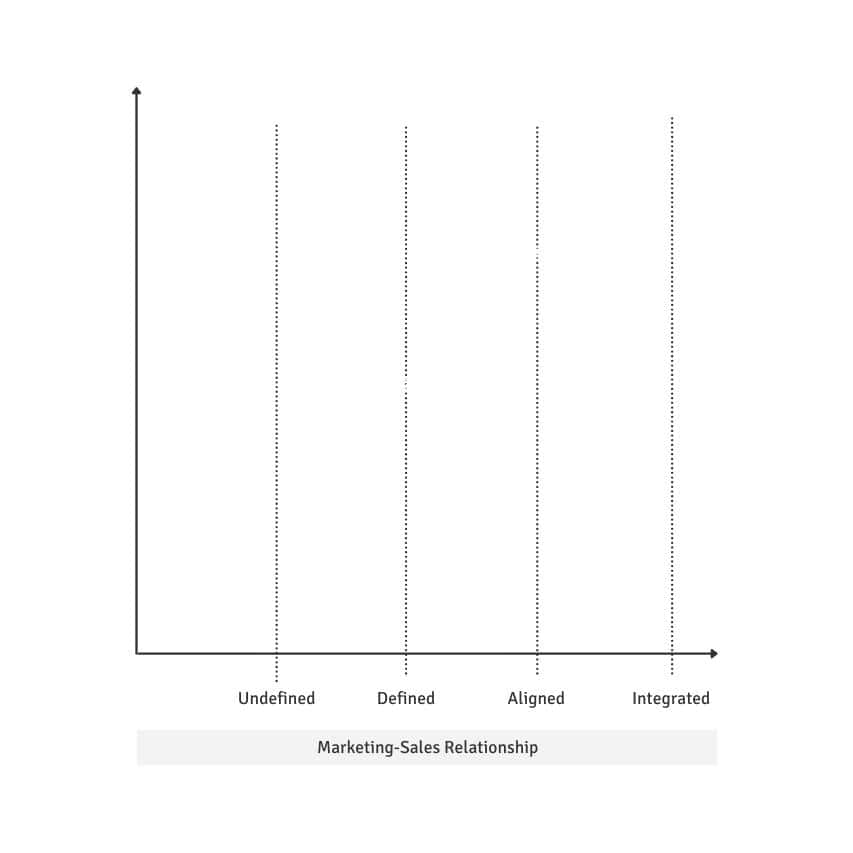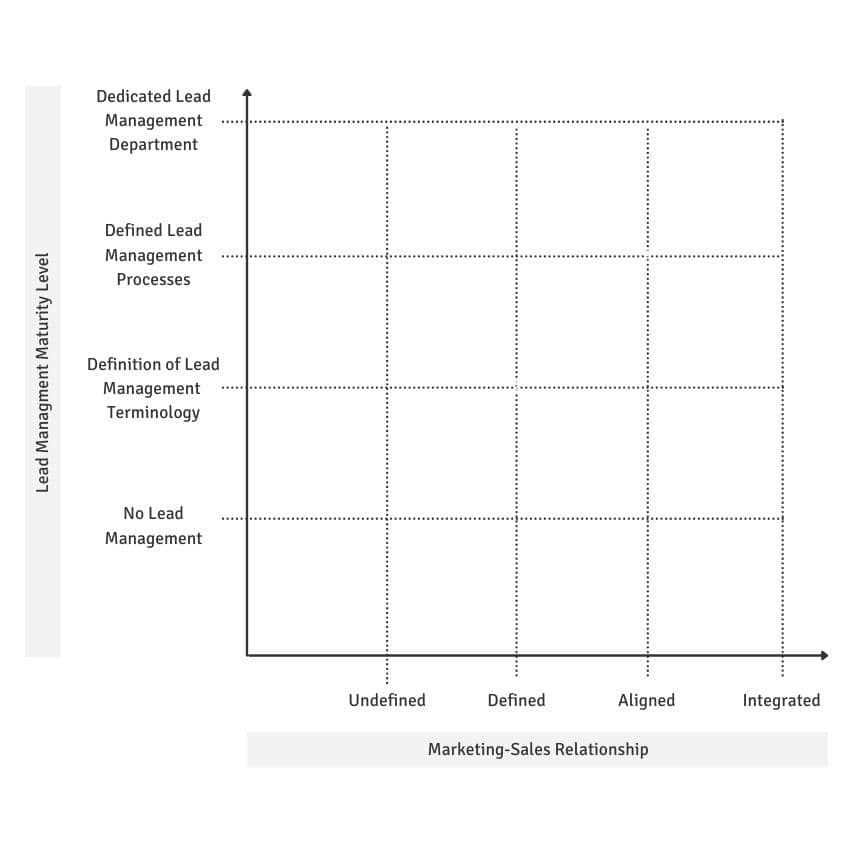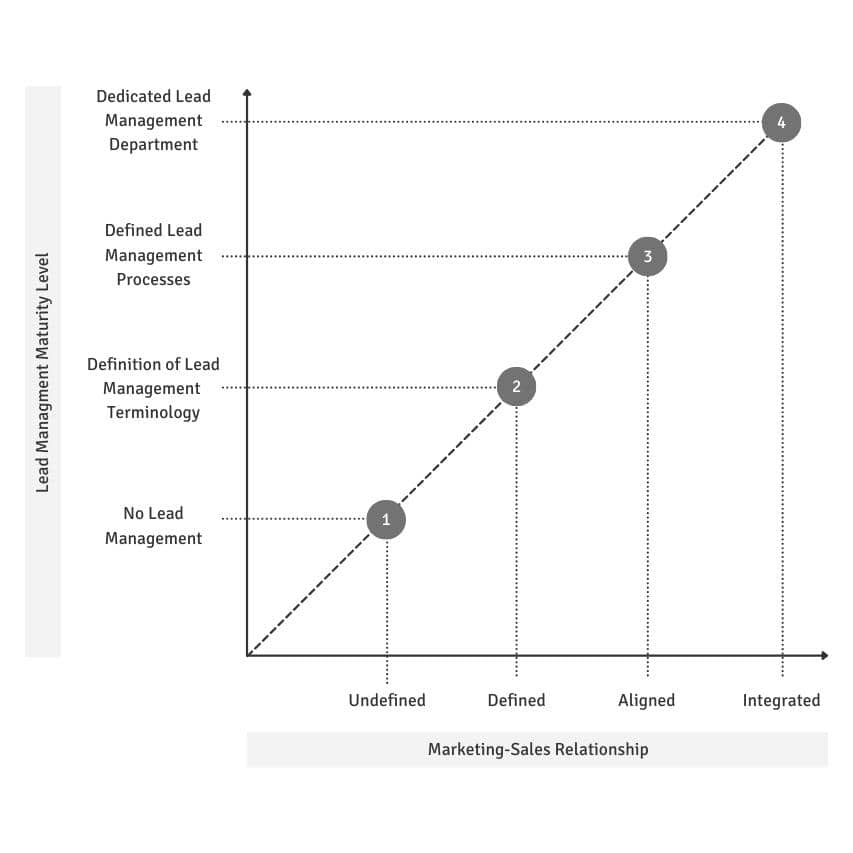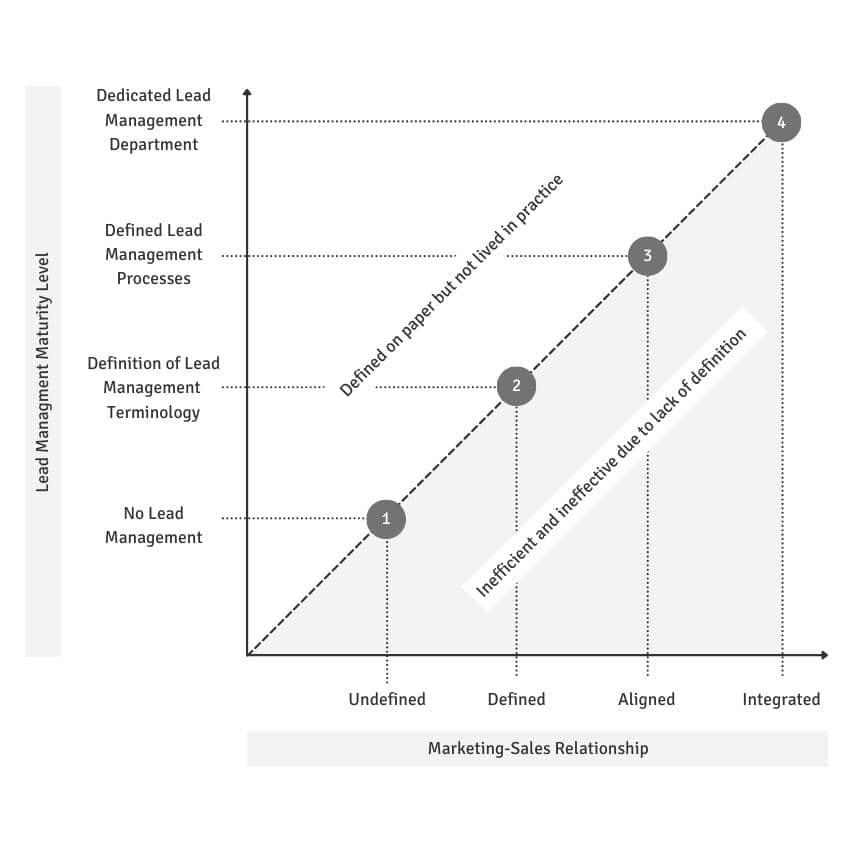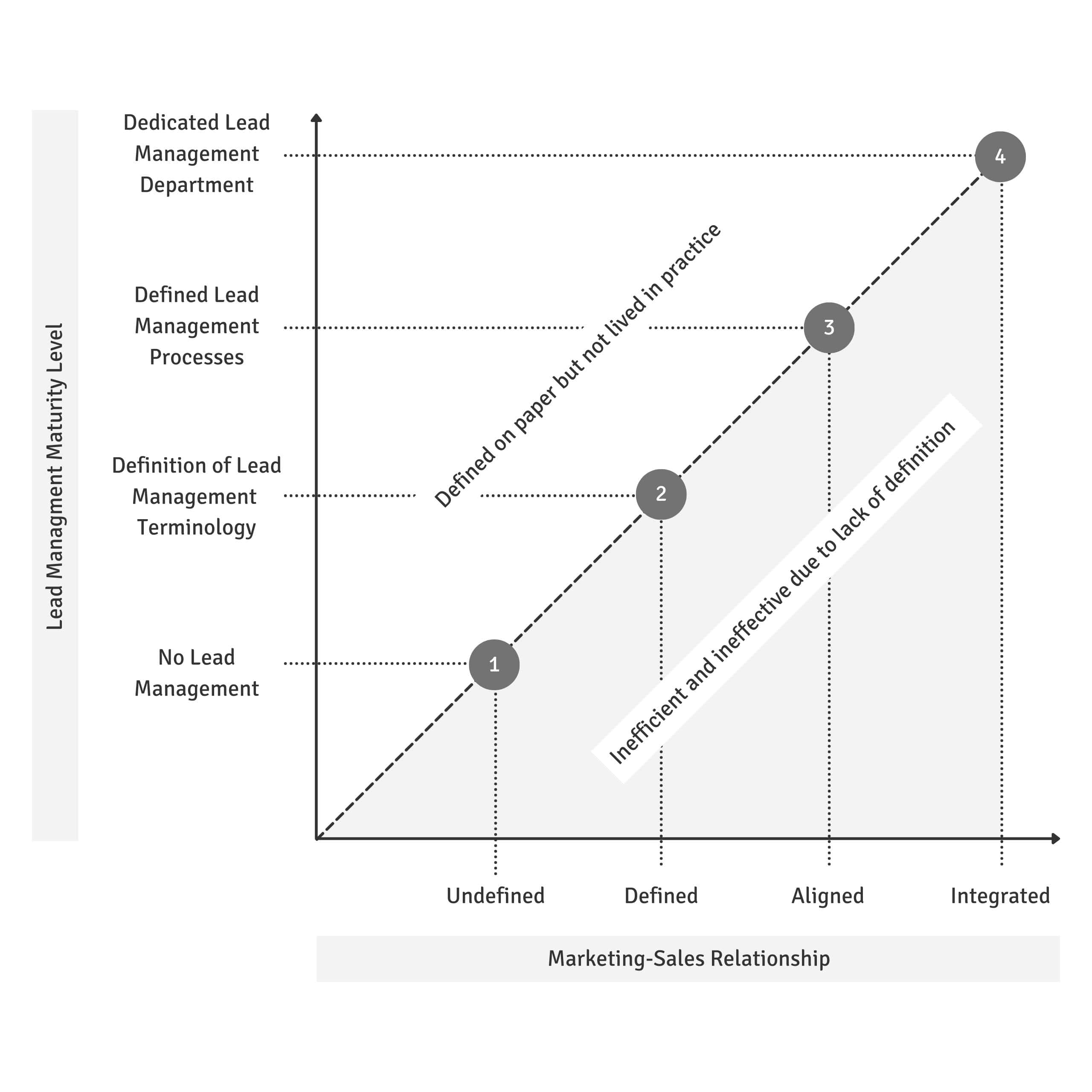Lead Management Maturity Model
Assess and Develop your Marketing and Sales Relationship
Marketing and sales play a vital role in driving business growth, but let’s face it, their relationship can be pretty challenging at times. This article dives into the importance of collaboration between these departments and explores some effective ways they can work together.
We discuss using maturity models to assess and develop your organization and establish a marketing and sales relationship. Lead management plays a vital role in this process, acting as the interface between these two essential departments.
One such model is the Lead Management Maturity Model, which combines the relationship status of marketing and sales with lead management maturity. This strategic management tool helps identify potential problems and pave the way for sustainable growth.
Additionally, this article also covers how to overcome these problems for sustainable growth.
So, let’s get into it!

3 Article Highlights
Table of Contents
Table of Contents
Newsletter
Subscribe and Learn B2B Marketing.
Marketing and Sales Relationship
The Importance to Collaborate for Growth
Marketing and sales need to work together. Period. Still, the relationship between these two departments is sometimes tricky. And sometimes non-existent.
Let us break this down.
And focus on how to establish a relationship that drives business and growth.
Marketing vs Sales
Marketing costs money. Sales earn money.
Marketing creates images. Sales is with the customer ensuring business growth.
It’s no secret that marketing and sales are two sides of the same coin, yet ironically, their relationship often resembles more of a rivalry than a partnership. This friction arises from differing goals and metrics. And a lack of understanding of each other’s roles. Marketing teams tasked with building brand awareness and generating leads often feel their efforts are undervalued when Sales teams, who focus on closing deals, don’t convert these leads into customers.
This disconnect is not just about missed opportunities. It is a symptom of a deeper problem where both departments operate in silos instead of using synergies.
These problems are even more true in business-to-business environments. B2B companies with grown structures focus on product management, R&D, and sales.
They lack to build B2B marketing departments at the same pace.
As a result:
- responsibilities are blurry,
- and the marketing and sales relationship is weak.
The COVID-19 pandemic accelerated the digitalization of communication and customer-centricity. Marketing typically owns digital communication. That makes it more critical than ever that marketing and sales closely collaborate.
Marketing is not measured by KPIs influencing revenue. At the same time, many B2B sales teams lack digital communication skills. This might be an overstatement. However, back in 2006, P. Kotler stated in “Ending the War between Sales and Marketing“:
“All too often, organizations find that they have a marketing function inside Sales, and a sales function inside Marketing.”
(Kotler, Rackham & Krishnaswamy, 2006)
How Does Marketing Increase Sales?
In essence, a common goal of marketing and sales benefits the company. This is not surprising as well-lead companies derive sub-strategies from a common, global corporate strategy. This includes the marketing strategy, contributing to the sales strategy and company branding goals.
In more detail, Marketing can increase Sales by leveraging data-driven strategies to understand customer behavior better. It is like being a detective, working through clues in the form of data to create a comprehensive customer profile. This information can then be used to craft targeted marketing campaigns that not only attract potential customers but also nurture them through the sales funnel.
Personalization is key here. The more relevant and tailored the marketing messages are, the more likely a potential customer is to purchase. By delivering the right content to the right person at the right time, marketing can hand over to sales not just leads but qualified leads ready for conversion.
Moreover, when businesses maintain a consistent brand message across all marketing channels, they can build trust and loyalty among their target audience. This brand consistency boosts the effectiveness of sales efforts. And creates a strong brand identity that connects with customers. When a brand delivers a consistent message, customers are more likely to recognize and trust it. This leads to increased sales and customer loyalty. By sticking to their brand values and promises, businesses can make a lasting impression on their audience and create long-term relationships.
These are just some of the benefits a strong marketing and sales relationship has.
B2B Marketing Maturity Model
What are Maturity Models and How to Use Them
Maturity models are super important in providing flexible performance monitoring and giving valuable insights into a company’s health and potential. They don’t directly address inefficiencies, but they’re a powerful tool for finding areas where organizations need to improve their game. With this knowledge, companies can develop effective strategies to improve operations and streamline processes.
Moreover, maturity models promote a culture of continuous learning and improvement. By assessing teams, individuals, or processes, these models show what changes are needed to take companies to the next level of growth.
What Is a Maturity Model?
Maturity modes are an essential instrument companies use to map their growth journey. Think of it as switching on your progress navigation system, laying out a clear path for improvement.
For B2B marketing, maturity models are used to evaluate and understand the state of marketing. The strength of a marketing maturity model is its capacity to assess qualitative data. This allows businesses to get a comprehensive perspective on their performance and long-term potential.
The burning questions become: Are we simply surviving or truly maturing? Are we stuck in a rut or actively evolving?
Marketing Maturity Model
Maturity Models also work for marketing, both in B2B and B2C markets. There are different concepts out there. The below 5 phases outline how marketing matures from zero to core function:
- Level 1 – The Survival Level
- Level 2 – The Basic Level
- Level 3 – The Operational Level
- Level 4 – The Strategic Level
- Level 5 – The Core Function Level
Level 1 – The Survival Level
The company has just started operating based on a product idea. They begin building a presence using marketing by simply presenting their product and its features to grab attention. Every company needs to create minimal attention to demonstrate positioning. That’s why this level is often referred to as the survival level.
Level 2 – The Basic Level
Once the business has established a basic presence, connecting with sales is next. This involves developing a sales and marketing organization and educating them about the common goals.
Level 3 – The Operational Level
At this stage, the marketing strategy mainly involves identifying potential customers and passing them on to the sales team. The company also engages in demand-generation activities to expand customer outreach and drive business growth. Marketing and sales start to work together.
Level 4 – The Strategic Level
At this level, marketing evolves from lead discovery to a strategic function where the quality of leads matters more than the volume. The business enables sales and marketing teams to strategically track and understand the buyer’s journey. Marketing has become essential for the company’s success.
Level 5 – The Core Function Level
By this stage, marketing evolves into a core business function and a driving force. The marketing team’s expertise is integral to the company’s decision-making process. It enables the organization to evaluate a product idea or modification against potential revenue, considering the estimated cost of marketing and sales. C-suite executives can align the company’s goals, R&D investments, financial scope, sales capacity, and more to maximize returns.
Lead Management
A Definition of Lead Management and How to Use it
The task of generating, nurturing, and qualifying leads can be assigned to either the sales team or the marketing team. As a result, the definition of lead generation can vary depending on whether it is approached from a sales-centric perspective or a more marketing-focused standpoint.
Definition of Lead Management
To grasp the concept of Lead Management and its core value, let’s take a step back and look at the bigger picture. Lead Management is the connection between marketing and sales, serving as the interface that connects the two.
Think of it as the middle part of the marketing and sales funnel, where leads are generated and nurtured, ultimately converting interest into desire.
Keeping all these aspects in mind, we can define Lead Management as the methodology, process, and software used to generate, nurture, and qualify leads using sales and marketing strategies.
This definition not only includes the lead funnel but also explains the three main functions of lead management:
- Lead Generation: It includes all measures to create cold leads and marks the interface between Marketing and Lead Management.
- Lead Nurturing: It is the central task of Lead Management and is defined as the methodology and processes to convert a cold lead into a qualified marketing lead.
- Lead Qualification: This task comes at the end of the lead funnel. This step is the interface between lead management and sales. Therefore, it reasons lead management output.
How to establish a Marketing and Sales Relationship
The above perspective implies that effective Lead Management can potentially align marketing and sales teams. It enables a seamless collaboration that can drive business growth and success. By strategically managing and nurturing leads throughout the customer journey, organizations can optimize their marketing efforts. And improve lead conversion rates and ultimately enhance overall sales performance. This alignment not only streamlines the customer acquisition process but also enables a more customer-centric approach. The results are increased customer satisfaction and long-term loyalty.
Marketing and sales are a team effort across the whole customer journey. This includes the:
- Marketing funnel
- Lead funnel
- Sales funnel
According to the “State of Marketing” report by Salesforce, marketing owns lead generation in only 32% of all cases exclusively. However, 65% claim that marketers contribute or co-own the process. This underlines how important a close collaboration between marketing and sales is.
This sets the scene for the strategic Lead Management Maturity Model.
This model aims to assess and develop a working marketing and sales relationship concerning lead management maturity.
Lead Management Maturity Model
A Strategic Management Tool
The Lead Management Maturity Model, short LMM-Model, is a maturity model to develop an organization focusing on its marketing, lead management, and sales departments. It takes the maturity of the marketing-sales relationship and the lead management maturity into account.
The LMM-Model has 2 axes, 4 crossing points, and 2 areas above and below the ideal development path.
- The x-axis describes the 4 relationship types between Marketing and Sales.
- The y-axis describes the 4 maturity phases of Lead Management.
- The 45° path with its 4 crossing points is the path to the ideal state of the three departments.
- The two areas below and above the ideal path describe deviations:
- Lead Management is defined on paper but not lived in practice.
- Lead Management is inefficient and ineffective due to a lack of definition.
Purpose of the Lead Management Maturity Model
Like any marketing maturity model, the LMM-Model is designed to assess the current state of affairs, specifically the relationship between B2B marketing and sales and the level of lead management.
It is important to note that this model does not provide immediate solutions to identified problems. However, its significant advantage lies in offering a holistic view of the mentioned departments and offers ways to enhance the marketing, sales, and lead funnel.
The Lead Management Maturity Model combines two key aspects:
- The status of the Marketing & Sales Relationship
- The maturity of the Lead Management process
The status of the Marketing & Sales Relationship
Kotler, Rackham & Krishnaswamy introduced four relationship types between these two departments: undefined, defined, aligned, and integrated.
The Maturity of the Lead Management Process
This perspective assesses how well and comprehensively a lead management process is established in your company. It can be described using four phases: No Lead Management, Definition of Lead Management Terminology, Defined Lead Management Process, and Dedicated Lead Management Department.
By considering both the relationship status and the maturity of the lead management process, the Lead Management Maturity Model provides a comprehensive framework for evaluating and improving lead management practices in your organization.
These are the 3 steps to create the model:
- Step #1: Marketing and Sales Relationship Status
- Step #2: Lead Management Status
- Step #3: Ideal Development Path of Marketing, Sales and Lead Management
Step #1: Marketing and Sales Relationship Status
We have already discussed marketing vs sales and how essential it is to establish a working relationship between the two departments. According to Kotler, Rackham & Krishnaswamy, there are 4 marketing-ales relationship types:
- Undefined
- Defined
- Aligned
- Integrated
Undefined
The relationship between the two departments is undefined. Both departments have grown independently and are not actively managed. They follow their targets and operate without much knowledge of the other discipline’s functions.
Defined
The defined relationship is characterized by clear rules that prevent disputes. Each department has well-defined boundaries and responsibilities. Both groups have a fundamental understanding of tasks that are important to both departments. They also share a common language, such as “how to define a lead”.
Aligned
Marketing and sales are aligned and have clearly defined responsibilities. However, rules and processes are flexible and based on mutual understanding. The two departments strive for the same goal and respect each other’s expertise. Marketers collaborate with sales on important accounts and/or opportunities.
Integrated
In a fully integrated setting, the boundaries between the two disciplines become blurred positively and beneficially. Processes and language are shared to commit to a common goal fully. Marketing and sales are no longer strictly separated but benefit from each other’s core competencies. They recognize that one cannot exist without the other.
Step 1 – Marketing Sales Relationship Status © B2B Marketing World
Step #2: Lead Management Status
The second part of the LMM-Model is the lead management status. Its maturity level is also described in 4 phases:
- No lead management
- Definition of lead management terminology
- Defined lead management process
- Dedicated lead management department
No Lead Management
There is no Lead Management department, and the organization does not actively manage leads. Typically, new sales opportunities are created by the sales team without a prior lead status.
Definition of Lead Management Terminology
The organization has established definitions for basic lead management terminology. The relevant parties, Marketing and Sales, have a basic understanding of leads. However, a lead management process is not fully developed, and there is no established system or software in place.
Defined Lead Management Process
The organization has a well-defined lead management process that clearly describes lead statuses. The lead management process is actively managed and continuously enhanced. The process responsibility lies with either the marketing or sales department, as there is no dedicated lead management department. The utilization of software supports the lead management process.
Dedicated Lead Management Department
A dedicated Lead Management department has been established. This department is responsible for generating, nurturing, scoring, and qualifying leads. It works closely with the Marketing and Sales departments. Roles and responsibilities are clearly defined, and there is a shared understanding of terminologies, processes, and objectives. The lead management software is deeply integrated into the CRM system and is mutually utilized by all departments within the company.
Step 2 – Lead Management Maturity Level © B2B Marketing World
Step #3: Ideal Development Path of Marketing, Sales and Lead Management
The combination of both axes gives us the option to develop an ideal relationship between marketing and sales using lead management. There are four steps for each axis, resulting in four intersection points where the two topics meet in the model.
These 4 intersecting points represent a significant milestone in the development process. Together, they form a 45° line known as the Ideal Development Path of Marketing, Sales, and Lead Management. This line serves as a guiding principle for optimal growth and success.
Let us have a closer look at the 4 crossing points, marketing important milestones:
- Undefined Relationship – No Lead Management
- Defined Relationship – Defined Lead Management Terminology
- Aligned Relationship – Defined Lead Management Process
- Integrated Relationship – Dedicated Lead Management Department
Undefined Relationship – No Lead Management
At this early stage, the marketing-sales relationship and lead management are undefined. Without a solid organizational framework, the company fails to leverage the potential of both marketing and sales fully.
Defined Relationship – Defined Lead Management Terminology
At the second level of maturity, the initial links between sales and marketing start to emerge, along with having a fundamental understanding of lead management. This stage serves as the foundation for future growth and greater maturity.
Aligned Relationship – Defined Lead Management Process
The third maturity milestone in an organization is characterized by a well-aligned relationship between marketing and sales, supported by a defined and implemented lead management process. This state has clear responsibilities and established rules on how to nurture potential customers and convert them into closed sales. The collaborative efforts show positive results and contribute to the company’s growth.
Integrated Relationship – Dedicated Lead Management Department
The most mature organization level has a dedicated lead management department responsible for the lead funnel. His department provides support to the fully integrated marketing and sales departments. The entire marketing-lead management-sales funnel is actively managed. All departments are aligned and seamlessly collaborate. This highest level of maturity significantly influences the company’s objectives. The goal is to sustain this level of maturity and effectively respond to evolving internal and external challenges.
It is time to discuss using the Lead Management Maturity Model and understand deviations to the ideal development path. This includes countermeasures to get back on track.
Step 3 – Ideal Development Path © B2B Marketing World
Use the Lead Management Maturity Model
Get Your Company Growth Back on Track
We have previously discussed the utilization of marketing maturity models, which serve as valuable management tools to drive growth strategically.
However, it is essential to note that while these models, including the LMM-Model, highlight potential problems, they do not provide solutions.
Therefore, I would like to offer some basic guidance on addressing these limitations based on your maturity level.
The areas above and below the Ideal Development Path offer valuable insights to unlock untapped potential.
Lead Management Maturity Model © B2B Marketing World
Above the Ideal Development Path
This area shows a higher maturity of lead management than the marketing and sales relationship. In a nutshell, this means that lead management is defined on paper but not lived in practice.
The absence of practical implementation stands out in the organizational states above the path. While lead management is advancing, there is a noticeable lack of relationship between marketing and sales.
This misbalanced situation leads to multiple problems.
Here are the most common problems and solutions to it:
- Underdeveloped Marketing – Sales Relationship
- Lead Management only in theory
- Wrong assumption “Lead Management does not work”
- High Cost
Underdeveloped Marketing – Sales Relationship
Lead Management only in theory
Wrong assumption “Lead Management does not work”.
High Cost
Below the Ideal Development Path
States below the path indicate that the sales and marketing relationship is more advanced than the lead management maturity. This leads to inefficiency and ineffectiveness due to a lack of definition of lead management processes.
While all states above the Ideal Development Path lack practical implementation, the maturity below the path has the opposite problem. The marketing and sales relationship is established and works fine. Still, the two departments lack efficiency and results.
This is because the company fails to establish a process for how leads are handled, including the lack of the necessary software, staffing, and other framework conditions.
Many companies face this status quo.
Here are the most common problems and solutions to it:
- Lack of Efficiency and Effectiveness
- No KPIs, no reporting, no monitoring
- Customer dissatisfaction
Lack of Efficiency and Effectiveness
No KPIs, no reporting, no monitoring
Customer dissatisfaction
Summary [TL;DR]
Marketing and Sales Relationship in a Nutshell
Marketing and sales are crucial for driving business growth, but their relationship is often challenging. This article highlights the importance of collaboration between these departments and explores how they can work together effectively. It emphasizes the need for a shared goal, leveraging data-driven strategies, personalization, and consistent branding to increase sales and build customer loyalty. Ultimately, aligning marketing and sales efforts can lead to long-term relationships and success for the company.
B2B Marketing Maturity Models are powerful tools that help companies assess their growth journey and identify areas for improvement. These models enable organizations to develop effective strategies and streamline processes. Here are the five levels of maturity:
- Level 1 – The Survival Level
- Level 2 – The Basic Level
- Level 3 – The Operational Level
- Level 4 – The Strategic Level
- Level 5 – The Core Function Level
Lead management is the crucial process of generating, nurturing, and qualifying leads, which can be handled by either the sales or marketing team. It serves as the connection between marketing and sales, incorporating:
- Lead generation
- Lead nurturing
- Lead qualification
The Lead Management Maturity Model (LMM-Model) is a framework that helps organizations develop their marketing, lead management, and sales departments. It assesses the maturity of the marketing-sales relationship and lead management practices.
- The model has two axes representing relationship types and maturity phases, with an ideal development path.
- The LMM-Model provides a holistic view of the departments and offers ways to enhance the marketing, sales, and lead funnel.
- It does not provide immediate solutions but helps identify areas for improvement.
To address the potential problems, it is important to consider your maturity level and leverage insights from areas above and below the Ideal Development Path.
- Above the path, there is a higher maturity of lead management on paper but not in practice, leading to a lack of relationship between marketing and sales.
- Below the path, the sales and marketing relationship is more advanced than lead management maturity, resulting in inefficiency and ineffectiveness. Establish lead management processes and necessary framework conditions to overcome these challenges.
Stephan Wenger
B2B Marketing Expert, Editor and Marketing Management Consultant
Stephan Wenger is a seasoned B2B Marketing Expert with more than 10 years of experience in leading global companies. His extensive expertise lies in the realms of B2B online marketing, content marketing, strategic marketing, and driving synergy between sales and marketing, including effective lead management.
You May Like the Following Articles

